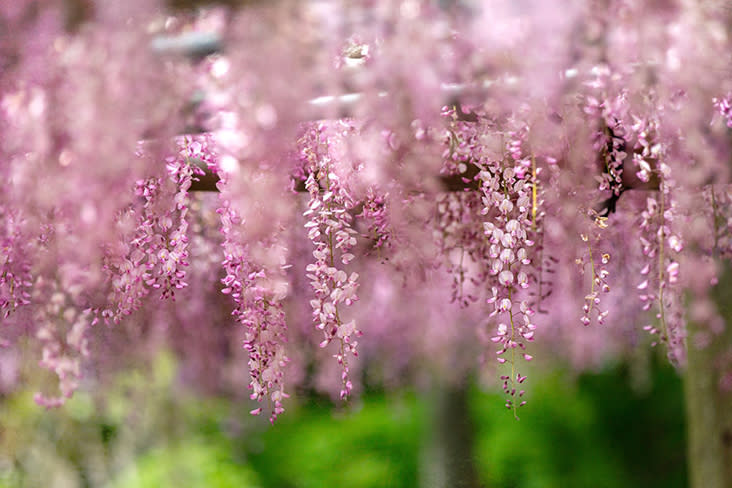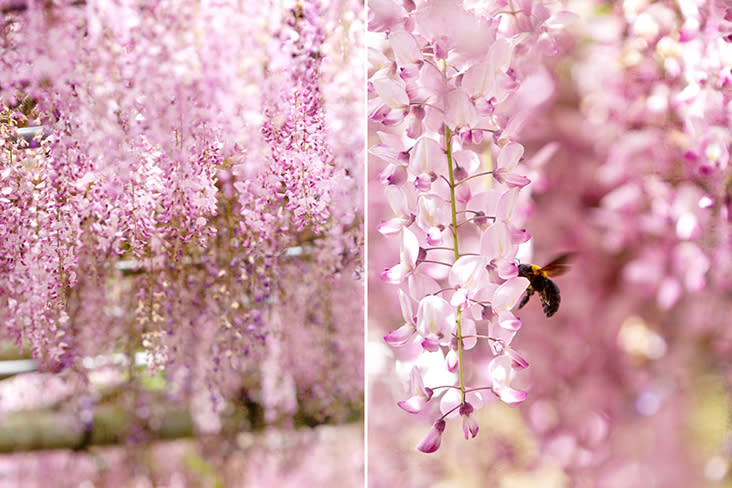The fleeting flowers of 'fuji': How the last blossoms of spring herald a Japanese summer

TOKYO, May 13 — It is the month of May. In Japan, this means it is the final turn of springtime blossoms, that last burst of colour and petals. Those fragile, brief blooms.
Perhaps the last flowers of the season are fuji, as wisteria is known in Japanese. These delicate flowers are late bloomers, appearing at the end of April and finishing their glorious parade in the month of May. Right before summer.
And what a way to go, to ring out the season!
A flowering climbing plant native to Japan, fuji is grown with an ornamental purpose in mind. Sure, there are wisteria bushes here and there where you least expect them, but by and large they are grown in gardens.
The better to display their elegant, pendulum-like flowers, you see. The slightly puckish way their determined vines will snake and clamber up both man-made pergolas and host trees in the wild. The flowers flourish, whether guided by human hand or by Nature’s art.

Fuji blossoms are the very definition of flower power as they do not come in a single shade. Some are pretty in pink; others promise a fuchsia fantasy.
Lighter than lavender, some beguile with their violets and purples. There are white showers of snowy wisteria blooms. All the colours hint at a mystery, a floral melody we can only ascertain if we linger a little longer.
If this were England, we might fear being lured to Faerie and be substituted; a changeling (or a Skrull, if you’re a Captain Marvel fan) in our place. Certainly the wisteria’s fragrance is potent and vinous, as sweet as fairy brew.
But this is Japan, so it is only kitsune or fox fairies we have to watch out for. That and the occasional tengu or forest spirit. Never tangle with a tengu (or so I learned from a children’s story years and years ago); we are sure to be worse for the encounter.
There is no danger. There are no traps.
The only creatures lured to these incandescent blooms are our insect friends. Like bees to honey (quite literally!), you may observe many tiny creatures flitting this way and that, but always towards nectar-rich wisteria blossoms.

The busy bees among the flowers are a sign that it is time to shake off the slowness and slumber and to warm up, to get ready to get cracking. There is work to do.
Change is in the air.
More than cherry blossoms earlier in the season – isn’t it strange that we always associate springtime in Japan with sakura when the Land of the Rising Sun has so many other awe-inspiring flowers? – or fiery-hued falling leaves later during autumn, wisteria is a signal of change.

Fuji’s fleeting flowers are the very last flowers of spring. Once they are gone, it is a matter of weeks before summer officially begins. The temperatures go up, there is more green in the world. Even what the Japanese eat shifts, every so slightly at first, then more dramatically as seasonal produce in the market changes.

Soon the flavours of spring will give way to the taste of summer. White strawberries with their intensely sweet fragrance will be replaced by thirst-quenching triangles of cut watermelon, perfect for the hot, sultry days.
There will be no more platters of grilled tai (sea bream) and mountains of tiny sakura ebi shrimp fritters. Instead, lovers of seafood will turn their gaze away from the deep waters of the ocean and look closer inland. The bounty of Japanese rivers offer freshwater eels or unagi, perfect for grilling over charcoal and dressed with a sweet and savoury sauce to whet heat-worn appetites.
Thick jackets and scarves will no longer be needed; there won’t be cold winds to ward off. Return those to the closet. As early as next month, thin T-shirts can be dug out of the wardrobe and after that, even less as the beaches beckon.
Yes, summer will arrive soon enough. That is the very promise of fuji. That the seasons change and that life – or at least Nature – goes on.
So we continue to wander among the wisteria. The dreamy clouds of buds and blossoms above our heads – not unlike puffs of cotton, not unlike cotton candy – take our breath away.

It’s curtain call. The last blossoms of spring herald a new summer. The whispering wisteria reminds us to slow down and to contemplate: how seasons will still come and go, whatever goes on in the human world.
Goodbye to spring and hello to summer.
But know that the seasons will repeat and soon we will admire the surreal glamour of fuji again, in pink and fuchsia, in violet and white. As fragile and as beautiful as our own brief spans on this blessed earth.
For more slice-of-life stories, visit lifeforbeginners.com.
Related Articles Philip Morris aims to phase out cigarettes in Japan within decade Japanese prefecture says deaths at home surge amid fourth Covid-19 wave Support for Japan govt hits new low as vaccinations progress slowly


